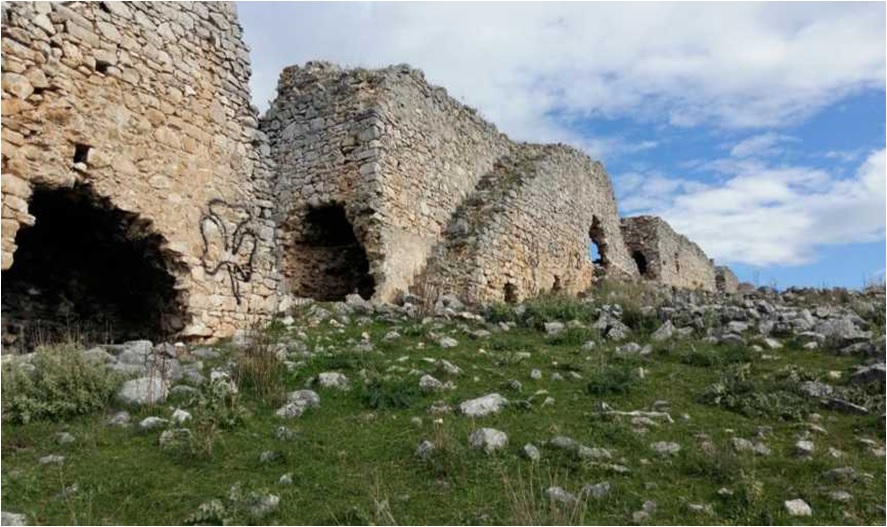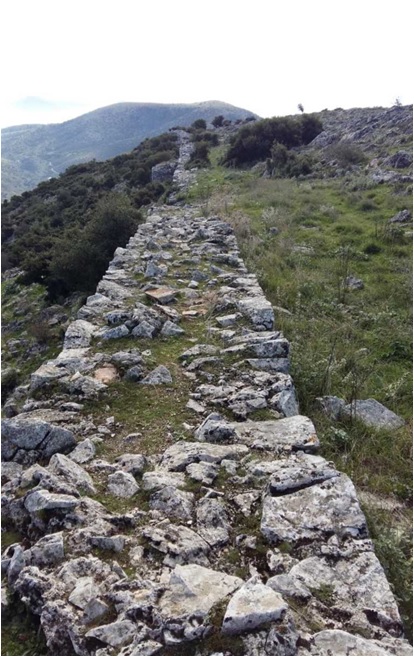It is located on a rocky hill above the village of Grizano Trikala (4 km to the northeast). It is a huge remarkable castle, which is preserved in relatively good condition. It has a perimeter of several kilometers and a height of 7-8 meters on its northern side. The wall starts a little outside the NE outskirts of the village, from the roots of the mountain almost, that is, where the I.M. of Agios Dimitrios and the Ancient Aqueduct and reaches the top of the mountain.

It is one of the largest castles in mainland Greece, with an area approaching 140 acres. This enormous size is quite unusual for a fortification that did not protect a large city or a notable fortress.
Judging by the lack of adequate historical references to the castle and the absence of discernible ruins of buildings within it, we conclude that, despite its size, the castle was never a city of any importance.
Location & Strategic Importance
The castle of Grizanos guarded the passes from Elassona – Kato Olympos to the Thessalian plain. It was located at a point that historically was on the border that separated Western Thessaly from Western Macedonia. For this reason, the area is scattered with outposts and forts of the border between Greece and Turkey during the period 1881-1912 (and the castle itself was used as one of these outposts).


Structural, Architectural, Fortified Elements
The castle is very large in area. The outer perimeter exceeds 2 kilometers enclosing a surface of approximately 140 acres. Approximately in the middle there is a transverse wall that divides the castle into two parts, of which the northern one is better fortified and probably older.
Along the walls of the northern part, square towers can be seen every 30 – 35 meters, the number of which is more than 20. The towers protrude about 3.5 meters from the wall and their length was 4.5 meters. The two corner towers of the north side are larger with side lengths of 6.30.
The wall consists of small irregular, half-hewn stones connected with mortar. Pieces of tiles are inserted in between (common practice to strengthen the bond of the stonework). The build isn’t particularly neat, but it was solid.
The form of the castle follows a model that seems to have been common in Macedonia and Thessaly sometime around the 10th century. Sprawling castles, with inner fortifications, built on rocky hills above plains, strongly fortified without elaborate masonry, but with many towers and much open space inside. Examples: Damasi, Moglena, Servia, Kastri Agias and others. Even in FYROM there are castles in this particular style. Some of these castles developed into famous cities (Moglena, Servia) and others remained in obscurity (Damasi, Grizano).
It is not certain what are the reasons that prompted the builders of these castles to choose such large dimensions. Perhaps the original plan envisioned the establishment of large cities that would gather the entire rural population. In some cases this plan succeeded and in others it did not (as in Grizano).
It is most likely, however, that only a part of the castle was intended for the settlement (or shelter) while the rest was intended for the herds!
Let us not forget that these are areas with a strong agricultural character, where cattle and goats and sheep were the most important asset of the inhabitants and the main target of predatory raids.


The name of the Castle
Apparently the castle and village got their name (which is of Slavic origin) from the large, long, gray rock on which the castle is built. During the Middle Byzantine period the name of the castle was Tziviskon. In a Norman chronicle it is mentioned as Cirisci.
The castle is linked by local tradition to Oria (beautiful) princess and her unlucky love. The princess fell in love with a simple soldier, not liked by her father. To avoid the punishment – prison imposed on her she fell from the walls of the castle. So Grizano is also one of the dozens of “castles of Oria” that exist in Greece.
Chronology – Historical course
The castle is definitely medieval, but the exact date of its construction is not known. As far as we know, it has not been studied and has never been the subject of archaeological research. Various sources claim that it was built in the 6th century AD. This is not excluded, but it is not certified anywhere. And it probably isn’t.
The assumption of construction in the 6th century is due to the fact that during the reign of the emperor Justinian (in the 6th century) too many castles were built or rebuilt throughout the Byzantine territory. That is why many castles whose origin is lost in the depths of time, go back to this period.
But Grizano cannot be one of them, as it is not among the castles of Thessaly mentioned by the historian Procopius in his work On Buildings. So the castle of Grizanos must not have been built then. Not even the next three centuries, as from the end of the 6th to the beginning of the 7th century the Slavs overran the hinterland of Thessaly which entered a dark period of oblivion and decline.
The most probable dating of the construction of the castle is at the beginning of the 10th century. At that time, around 930, it is known that the Byzantine emperor Romanos Lekapinos had built castles in western Thessaly and in western Macedonia to stop the expansionist tendencies of the Bulgarian ruler Simeon I.
We do not know exactly which castles were built at that time, but it is likely that castles such as those of the Serbs, the Moglens, the Damasios, the Grizanos, etc., were built then. Another, less probable hypothesis regarding the time of construction is that it was built towards the end of the 11th century, when a new nomadic and occasionally warlike race appeared in Thessaly, the Vlachs, first mentioned by historical sources in 1075 The spread of the Vlachs was so great that Thessaly in the next three centuries was referred to as “Wallachia” or “Greater Wallachia” or “Greater Wallachia”.
The castle was probably created to watch over the newly arrived Vlachs. It is still possible that it was built by a Vlach chieftain, since it appears from various incidents that the Vlach warlords had gained enough power and were able to build castles to consolidate their authority locally or to make a show of wealth and power. This hypothesis is strengthened by the unjustifiably large size of the castle which may be an element of neo-wealthy display, but also an indication that there were a large number of defenders available who obviously did not come from an urban population (since there was no city at this point). It is certain that the castle existed in 1082.
In that year, the Norman Bohemund captured it during his campaign in Thessaly. A few months later, Bohemundus was defeated by the Byzantine emperor Alexios I Komnenos who rushed to prevent the capture of Larissa.
The incident with the capture of Grizanus by Bohemundus is mentioned by Anna Komneni in her historical work “Alexiada” (Alexias, 5.5.3) and by the French (or Italian) chronicler Guillaume de Pouille or Guglielmo di Puglia or Guillelmus Apuliensis) in his chronicle of the works and days of Robert Guiscardos.
Anna Comnini mentions the castle as “Ziviskon” or “Ziviskou” and William as “Cirisci”. The two names are generally identified with Grizano. These two historical sources are the only ones that mention the castle of Grizanou (by any name).
After the Bohemund takeover incident, the castle is never mentioned again in either medieval or Ottoman sources (as far as we know). It is not present either in the narration of the various episodes concerning the state of Thessaly or the Despotate of Epirus or, in the early 14th century, with the fief of Gavriilopoulos or in the events surrounding the Ottoman conquest. It does not seem to have been used during the Turkish occupation.
The lack of historical records does not necessarily mean that the castle was not in use, but we can assume that it never developed into an important city and was very likely abandoned relatively early. In relation to this we should note that the large perimeter of the walls made it difficult to defend the castle. However, it is possible that it was used for some time as a shelter in case of raids (but not as a fortress or settlement).
With the liberation of Thessaly in 1881, the castle housed within its walls a Greek outpost of the Greece-Turkey border line. After the unfortunate war of 1897, the borders at this point changed little, but the castle passed to the Turkish side, so on the Greek side, another border fort was built nearby, the Grizanou fort. This role of the castle lasted until 1912.


The castle today
The best preserved part is the northern part where the walls are preserved at a height of 7 – 8 meters. The side of the castle that is in the worst condition is the southwest, which seems that being lower and closer to the village it was stoned more easily.
On this side the walls went down very low, to the limits of the present village. This expansion was probably done to protect access to a water source that was apparently critical to the castle’s water supply.
Few ruins of buildings can be seen inside the castle. Which is strange. In other regions of Greece, much smaller castles enclose entire castle states.
In the center of the northern part there are the remains of a building which was probably the Greek outpost that we know was there after 1881.





